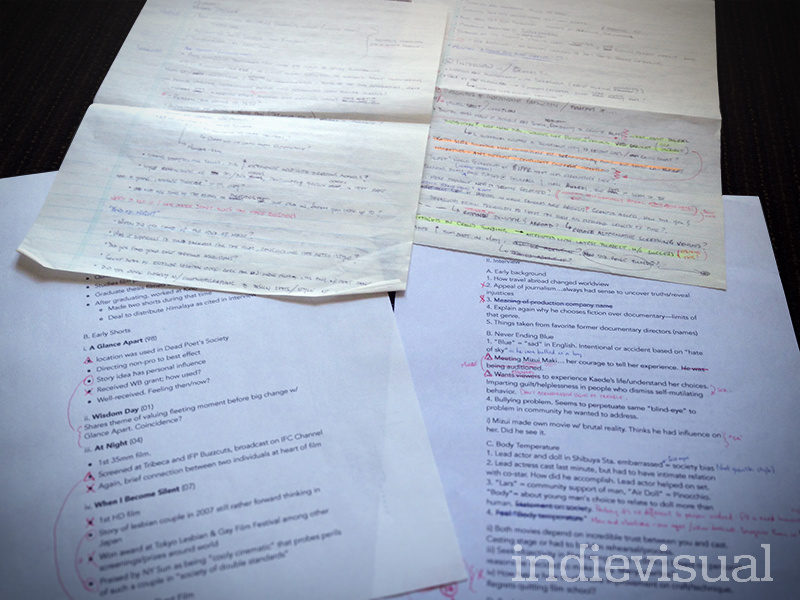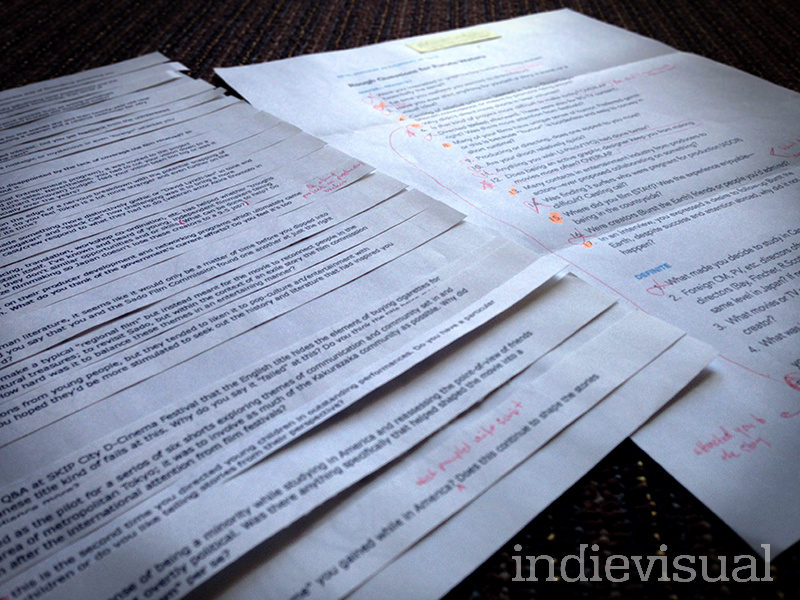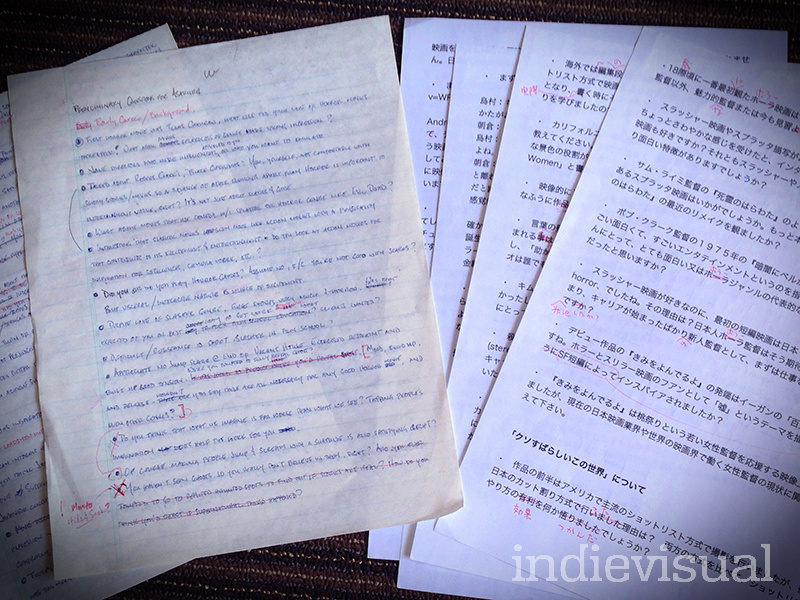Now that I have taken copious notes on the subject as described in the first part of the series, the time has come to make use of them. This stage of the process is likely the most difficult as the information gathered will begin to dictate both the structure of the interview as well as the kinds of questions I can (or can not/should not) ask. Initial ideas which surface as research is being done are filtered through the outlining and question writing phase leading some to either be adopted “as-is”, adapted for a different purpose, or left out entirely. The title of this second part, Making Inquiries, while a play on words describing what happens at this stage, also appropriately expresses the importance of constantly reviewing and analyzing the notes I’ve taken, the ideas they form, and ultimately the tone and balance of the interview itself in order to realize a questionnaire that is ready for the subject.
Outlining
The first order of business is finding out what my notes are telling me. Looking across their entirety will show me the titles most often mentioned or featured in interviews with the subject. Even if a specific movie will take the majority of the limelight because of where the filmmaker is in his or her career, questions and responses in interviews will bring up other works as either points in passing or a specific topic. These will then begin to reveal common subject matter or concerns that repeat through their career and thus in their filmography….
(Paper, Pen, Keyboard – part 2 cont.)
As these common occurrences begin to line up, what is revealed hints at the structure of the interview; titles in their career to touch upon, themes in their filmmaking worthy of examination. Then, using the side comments and questions I’d written to myself to filter these out of or in to the interview, the structure of the outline, for the most part, takes form.

Either roughly written or typed then printed, the outline goes through numerous revisions
Like in any other outline, the first roman numeral is often the Introduction which, no pun intended, needs no introduction while the final section is the Conclusion, or in this case the Filmograpy. They’re single words on the outline, nothing more. Where I focus my attention is in the main section; formally the Body of a text. In the case of Indievisual, this is the Interview. As I want to focus the interviews on the subject themselves, I have made a conscious decision not to cover just one or two of their movies. This would make the interview seem like the publicity interviews filmmakers do when promoting their latest movie. My goal is to present an overall profile of the subject across the trajectory of their career up to that point. Thus, as a kind of warm-up, the interview will first deal with their youth as it relates to ultimately making the decision to becoming a filmmaker. Next will come early works–either done prior to film school and/or as products of their education. I like to touch upon this period in their career as this is the time they and their ideas are at their most raw. And, as they develop, one can see the origins of the themes and style which manifest in later works covered in the following section. Among these I will focus on their most notable and/or recent work since the bulk of information I am able to obtain usually pertain to these titles. But if I’ve structured the outline properly, the interview will organically turn its attention to these titles in the build-up to the current phase of their career. Finally, the interview closes out with a section dealing with the future since it’s never too early to create awareness for what is coming next or at least what they plan to do. With the general flow of the interview and the works to be touched upon determined, the blueprint now exists for me to move on to the heart of the entire interview process.
Writing Questions
It’s said creators make the things they would use themselves, or in the film world, directors make the movies they would watch themselves. Likewise, I ask questions to find out things I want to know myself. The caveat, of course, is not everyone is necessarily interested in what I particularly want to know. The point is to strike an appropriate mix of common and cinephile queries. To do this, I have set a few rules for myself regarding the kind of questions I want to avoid. The first are rudimentary questions such as “Who’s your favorite director?” “Can you remember the very first movie you watched?” Because the number of questions are limited, it’s best to just move on to questions with a bit more depth; sometimes the respondent will naturally relate such information as part of an answer. The second is overly personal questions. Most of the time, I have not personally met or know the interviewee well enough to make such queries unless they have talked about such matters publicly before. In that case, I may pursue more details as they relate to their work. Finally, I want to avoid questions similar to those asked of them in past interviews. Such questions have already supported my research so there’s no need to have the subject revisit them.
Conceiving of the questions is a matter of running down the outline and referencing the notes I have taken to create a list of rough questions. Often I will be able to come up with around 30 or 40 questions which then must be edited down to 25; not an easy task as cutting questions I truly want to ask can prove Herculean. Fortunately, the cunundrum can (sometimes) be solved by merging questions together. But in the end, I need to prioritize which questions facilitate the structure of the outline more effectively. From there, I refine the questions further before rewriting the finalized questionnaire into Japanese.

Creating cutouts of questions, one early method of editing and finalizing the questions list
Unlike taking notes, which I translate from Japanese to English–which comes easier to me–now I need to do the reverse. Writing in Japanese, though I can speak the language, is a challenge. As I’ve stated in Part 1, English is my native language, therefore, I conceive of my questions in English. Problems arise when translating these questions to Japanese. For one, terminology can and is different. I know enough about filmmaking and the film business to use the proper terminology, but those are often not the words used in Japanese. In fact, the terms can occasionally be so different as to make researching them based on their English counterpart practically impossible. In these instances, I must either turn to a filmmaker friend, or slightly change the question to better match the term I am able to find. Second, some terms are so new to the filmmaking lexicon, like “Audience Building,” that it has yet to see an officially acknowledged equivalent. This is when I must turn to “katakana,” the phoenetic alphabet used in Japanese to express foreign words or concepts; but even this is harder than it seems as how a syllable sounds to me can be slightly different to a Japanese. I often come across katana words expressing a western word which phonetically is spelled differently from how I would pronounce it. So, attempting the reverse from English to Japanese is not as straightforward as one might imagine. Beside these technical hurdles, there are cultural considerations as well.

Initial pass at translating English questions to Japanese and revisions to follow
The first of these is the decorum characteristic of and essential to the Japanese language; what is known as the “honorific” form of the language. Basically, this is a more formal way of speaking or writing Japanese as a means of displaying respect akin to a butler or maid addressing the master of the house, except there are specific words and verb-forms which must be used. For westerners studying Japanese, this aspect of the language is most likely the most difficult to grow accustomed to using. While I don’t utilize the most formal variation of the language, the need for me to show deference to the interviewee requires I at least use standard honorifics. Doing so essentially means reinterpreting questions written in conventional (read: not casual) English into respectful Japanese. This leads to the second point of consideration with regard to culture, and that is asking straightforward “who, what, when, where, how & why” questions do not lend themselves well to honorific interpretation. In fact, it’s almost always necessary to rephrase them. Instead of asking, “Who are your favorite directors?” it is more polite to ask, “Could you please tell us which directors are your favorite?” Of course, you wouldn’t write in English this way, but the need for such phrasing to show the proper respect to the interviewee creates interesting challenges for this stage of the process particularly since my questions are more complex than the rudimentary example above.
Once the Japanese language version of the questionnaire is completed and submitted to the interviewee, I wait while moving on to producing the next questionnaire. Filmmaker schedules don’t always allow for a prompt return–sometimes responses arrive in sections–but once I have them, I will then move on to most labor intensive phase of completing the full interview article: Write, Edit, Rewrite, and Repeat.
